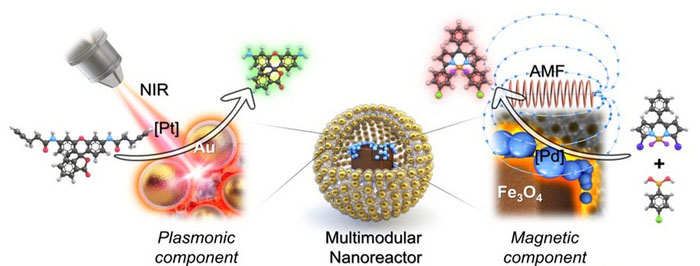Nanoreactors: Tiny Vessels for Controlled Chemical Reactions
What are Nanoreactors?
Nanoreactors are nanoscale structures that enable chemical reactions by providing either a confined environment or active surface areas for reactants to interact. While some nanoreactors offer internal spaces, others, like quantum dots, act as catalytic sites on their solid surfaces. Spanning from a few nanometers to several hundred nanometers, these tiny entities have a distinct advantage over larger-scale reactors. Their high surface area relative to volume allows for greater control over the conditions affecting molecular reactions, leading to increased efficiency and specificity in catalytic processes and synthesis.

Key Concepts in Nanoreactors
Nanoreactors leverage several key concepts to enable controlled chemical reactions at the nanoscale:
- Confinement Effect: By encapsulating reactants within a nanoscale space, nanoreactors can enhance reaction rates, selectivity, and efficiency. The confinement effect arises from the increased probability of molecular collisions and the altered chemical environment within the nanoreactor.
- High Surface-to-Volume Ratio: Nanoreactors possess a high surface-to-volume ratio, which provides a large interfacial area for catalytic reactions and enables efficient mass transfer between the reactants and the reactor walls.
- Controllable Reaction Conditions: Nanoreactors allow for precise control over reaction parameters such as temperature, pH, and reactant concentrations. This level of control enables the study of reaction mechanisms and the optimization of reaction conditions for specific applications.
Types of Nanoreactors
Nanoreactors can be classified into different categories based on their composition and structure:
Nanoparticle-Based Reactors
Nanoparticles, such as metal nanoparticles, quantum dots, and polymer nanoparticles, can serve as nanoreactors by providing a catalytic surface or a confined reaction space. These nanoparticles often possess unique optical, electronic, or magnetic properties that can be harnessed to drive chemical reactions or enable in-situ monitoring.
Vesicle-Based Reactors
Vesicles are self-assembled, hollow structures formed by amphiphilic molecules, such as lipids or block copolymers. These nanoscale compartments can encapsulate reactants and catalysts, creating a controlled environment for chemical reactions. Vesicle-based nanoreactors have been utilized for enzyme catalysis, drug delivery, and artificial cell mimics.
Nanoporous Materials as Reactors
Nanoporous materials, including zeolites, metal-organic frameworks (MOFs), and mesoporous silica, possess well-defined pore structures that can act as nanoreactors. The pores provide a confined space for reactants to interact, while the pore walls can be functionalized with catalytic sites or selective binding moieties. These materials offer high surface areas, tunable pore sizes, and the ability to control mass transport.
Applications of Nanoreactors
Nanoreactors find applications in various fields, including catalysis, drug delivery, and artificial cell development:
Catalysis
Nanoreactors are extensively used in catalytic processes, where they can enhance the activity, selectivity, and stability of catalysts. By encapsulating metal nanoparticles or enzymes within nanoreactors, researchers can create highly efficient and recyclable catalytic systems for various chemical transformations, such as hydrogenation, oxidation, and polymerization reactions.
Drug Delivery
Nanoreactors can be designed to encapsulate and deliver therapeutic agents in a controlled manner. By incorporating stimuli-responsive materials or targeting ligands, nanoreactors can release drugs at specific sites or in response to external triggers, such as pH changes or light irradiation. This targeted delivery approach can minimize side effects and improve the efficacy of drug treatments.
Artificial Cells and Organelles
Nanoreactors offer a platform for creating artificial cells and mimicking the functions of natural organelles. By encapsulating enzymes, genetic materials, or synthetic components within vesicles or nanoparticles, researchers can develop artificial systems that exhibit cell-like behavior, such as energy production, signal transduction, and self-replication. These artificial cells have potential applications in synthetic biology, biotechnology, and medical diagnostics.
Challenges and Future Perspectives
Despite the significant progress made in nanoreactor research, several challenges remain. Scalability, reproducibility, and characterization of nanoreactors are key areas that require further development. Future research directions include the development of multi-functional nanoreactors, integration with microfluidic devices, and the exploration of bio-inspired designs.
As nanoreactor technology continues to advance, it holds immense potential for revolutionizing chemical synthesis, drug delivery, and the development of artificial cellular systems. By harnessing the power of nanoscale confinement and control, nanoreactors offer a promising platform for addressing challenges in catalysis, medicine, and synthetic biology.
Further Reading
Journal of the American Chemical Society, Nanoreactors: Small spaces, big implications in chemistry
Beilstein Journal of Organic Chemistry, Nanoreactors for green catalysis
Current Opinion in Biotechnology, Advances in nanoreactor technology using polymeric nanostructures
